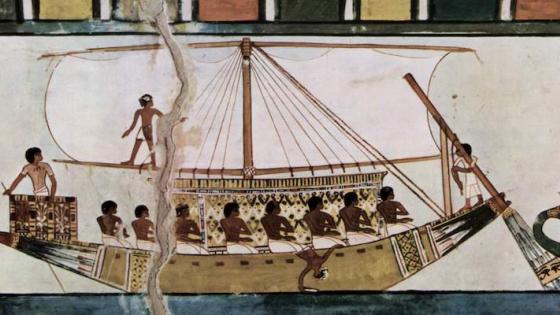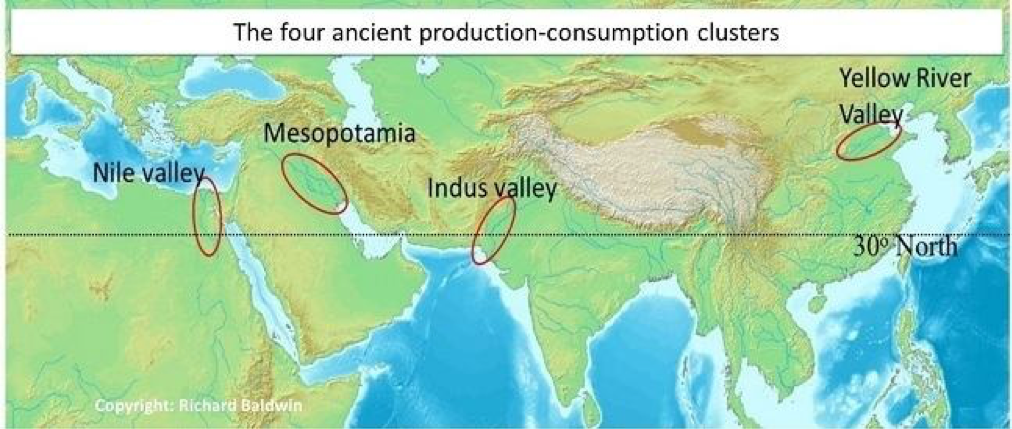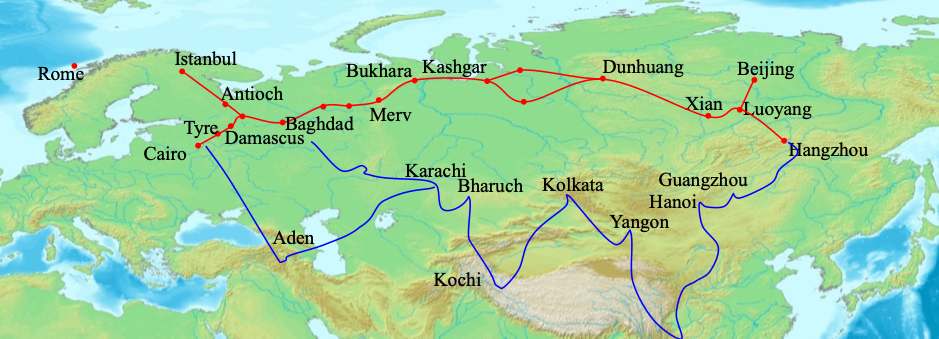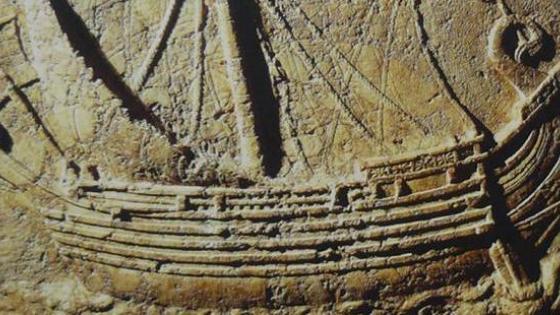Climate scientists don't know why, but, starting 20 millennia ago, the earth’s climate began to warm. There is nothing exceptional about naturally occurring climate change. What is perhaps more odd is the fact that, 12,000 years ago, the climate stabilised. All of human civilisation arose, cities and civilisations, industry and long-distance travel, and all of what we call history occurred – and was written down – during this time.
Human population density was limited by food, and food was limited by climate. When climate warming triggered a transformation of human society, it indirectly triggered globalisation. Population density rose in places with long growing seasons and reliable water sources. With lots of people clustered together who needed to be fed, humans gradually learned how to move food production to people more efficiently. This was the agricultural revolution which happened around 12,000 years ago, or 10,000 BCE. Although it is hard to precisely date its development, it is clear that it developed separately, at about the same time, in many regions. Most historians, however, believe that it first started in the Fertile Crescent, the region that today is Iraq, Iran, and the eastern part of Turkey. But, soon after, there is evidence of agriculture in Mesopotamia, the Yellow River valley, and the Nile valley.
Agriculture’s earliest shoots sprung up in four river valleys: the Nile delta, Mesopotamia, the Indus River valley, and Yellow River valley. All are at a latitude of around 30 degrees north. This is a sweet spot for agriculture, not too hot and not too cold (Figure 1)
Figure 1 The four clusters of civilisation, 10,000 BCE
Source: Background map from Wikicommons with routes added by author based on various sources.
Why river valleys? Annual flooding solved a critical problem facing ancient farming, which had kept early farmers on the move. Without fertiliser, farmland loses much of its ability to grow crops in just a few years, but annual floods prevented soil exhaustion.
The agricultural revolution was a process that took centuries – it wasn’t an overnight change. But it was revolutionary in terms of its impact on how humans lived. For the first time, people could stay in the same place for centuries. This stability, together with the superior caloric value of farming, allowed things to accumulate – things like buildings and irrigation canals, but also culture and knowledge. People built cities and societies. These, in turn, led to the development of almost every basic element of human civilisation we know today – everything from writing and religion, to laws and metalwork. The world economy was, in other words, 'localised' in the sense that production and consumption occurred in fixed locations.
Foundations of civilisation
If the modern world were a house, this phase would be its foundations. All the trappings of civilisation took their modern forms at this time – everything from writing and worship to governments and gunboats.
Phase 2 covers thousands of years, and there are many ways to slice up the centuries. I find it easiest to understand, teach, and remember Phase 2 by dividing it up into three stages: the rise of Asia, the integration of the Eurasian landmass, and the rise of Europe.
The rise of Asia (10,000 BCE to 200 BCE)
We have seen that the ancient Eurasian civilisations – Egypt, Mesopotamia, India/Pakistan, and China – arose around river valleys. Some trade happened among the three western-most clusters (Egypt, Mesopotamia and India/Pakistan), but transport technology was primitive, so it was limited to obtaining raw materials that were unavailable locally and to supplying the elite with trinkets.
China was not involved in this trade due physical barriers (the Tibetan plateau, the jungles of southeast Asia, and the long ocean route to get around them). This is one possible reason that Chinese culture is still so different to ‘western’ culture, which, up to recent centuries, was located around the eastern Mediterranean and connected for millennia to Northern India and Pakistan.
Eurasian integration (200 BCE to 1350 CE).
In the second stage of Phase 2, the Silk Road united the Eurasian continent (Figure 2).
Figure 2 The Silk Road by land and sea around the Year 1
Source: Background map from Wikicommons with routes added by author based on various sources; the map uses modern city names where possible.
The Silk Road opened around 200 BCE and formed the first sustained connection between the economic clusters at the East and West ends of Asia. Trade flowed by land and by sea, reaching its zenith around 1300. It is commonly said to have been shut down in 1453 when Constantinople fell to Islamic armies, but its closure was reinforced by the Ming Dynasty’s decision, a couple decades later, to turn its back on sea-borne trade.
That decision is often underappreciated in the West. China had been an important trader for centuries. One of the most spectacular events in China’s early globalisation was the voyages of Admiral Zheng He from 1405 to 1433. According to contemporary sources, the first expedition involved more than 27,000 men, 62 treasure ships and 190 smaller ships. One of Zheng He's treasure ship was more than 120 meters long. In comparison the Santa Maria, the ship commanded by Christopher Columbus when he discovered the New World, was about 30 metres long.
This second stage of Phase 2 lasted a long time. For fifteen centuries, the four original clusters were connected by land and sea. Trade was regular, but scarce. To give an example, it took the famous traveller Marco Polo three years to travel overland from Venice to China in the 1200s. He returned by sea, a voyage that took another two years.
The rise of Europe (1350 to 1820)
A major shock to the world’s economic geography came with the Black Death (bubonic plague). This defines the beginning of the third stage of Phase 2.
Moving from east to west along the Silk Road, the plague reached Europe in the 1340s. The disease killed up to half of all Europeans in just three years. It had a similarly terrible impact on the Islamic world, which dominated three of the four ancient civilisations in the 'golden age' of Islam (Europe at that time wasn’t a comparable centre of civilisation). The plague seems to have had much less effect in south and east Asia.
For reasons that historians argue about, this shock shifted Europe onto a positive-growth path, but did the opposite for the Islamic world (see In the Wake of the Plague by Norman Cantor, or Power and Plenty by Ronald Findlay and Kevin O'Rourke). The rise of Europe was also facilitated by China’s decision to turn inward, thus removing a major block to global domination by north Atlantic countries.
Compared to the advanced civilisations in Asia, western Europe had been a primitive backwater during the centuries before the Black Death – that is why they are known as the Dark Ages in Europe. Southern Europe was the exception during a few glorious centuries when the Greek and Roman Empires flourished. Starting from the 1500s, the world order was turned on its head. The periphery became the core and the core became the periphery. Europe transformed itself into an economic entity that would soon tower over the world economically, militarily, and culturally.
The key features of this reversal of fortunes were new thinking (the Renaissance and Enlightenment), new lands (the Age of Discovery brought the Americas into the Eurasian world system), and new foods (for example, potatoes and maize) that allowed Europe’s population density to rise. Also important was the Industrial Revolution. This was a small British bushfire at the end of Phase 2, but it became a global firestorm in Phase 3.
References
Baldwin, R (2016), The Great Convergence: Information technology and the New Globalisation,Harvard University Press(chapter 2).
Cantor, N (2002), In the Wake of the Plague, Harper Perennial
Findlay, R and K O'Rourke (2009), Power and Plenty, Princeton University Press.





